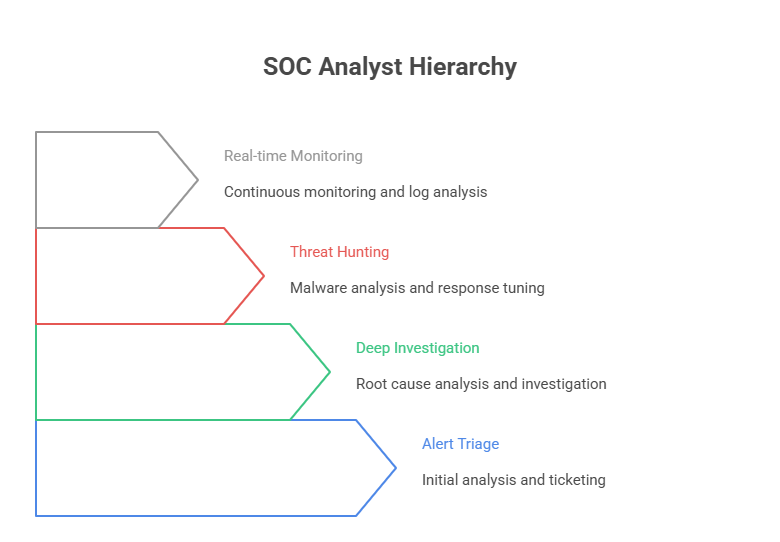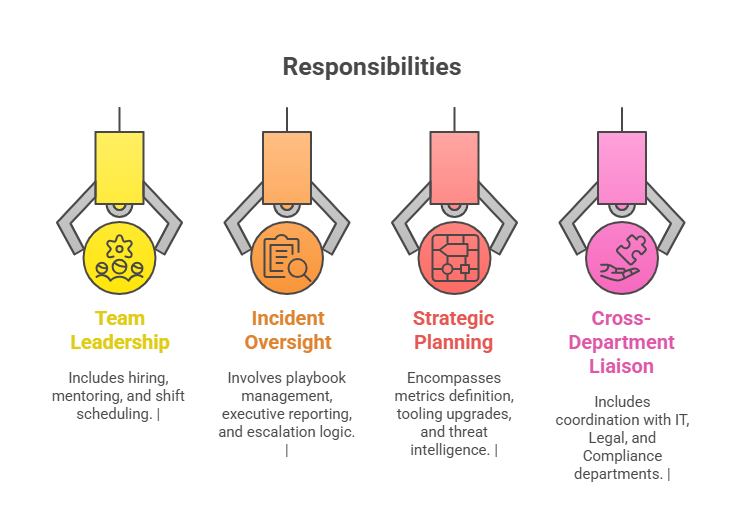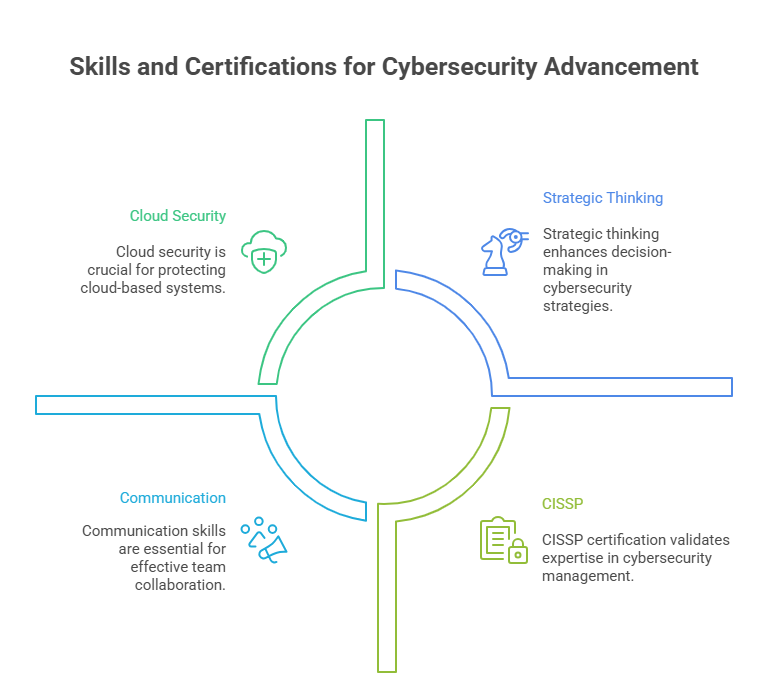From SOC Analyst to SOC Manager: Step-by-Step Career Advancement Guide
The leap from SOC Analyst to SOC Manager isn’t just a title change—it’s a transformation in responsibility, scope, and long-term career trajectory. Analysts focus on detection, triage, and technical response. Managers oversee strategy, people, and the overall security posture of the organization. That jump demands more than experience—it requires planning.
Advancing to a SOC Manager role unlocks access to six-figure salaries, strategic influence, and leadership roles in cybersecurity. This guide walks you through the real steps—from sharpening your tech and soft skills to proving leadership potential and securing internal promotions. No fluff. No theory. Just the tactical moves that actually get you promoted in modern security operations centers.
What is a SOC Analyst?
A Security Operations Center (SOC) Analyst is a cybersecurity professional responsible for identifying, investigating, and responding to security threats in real-time. Their core role is to monitor logs, detect anomalies, and escalate or resolve incidents based on organizational protocols. It’s the first line of defense—and the backbone of any 24/7 security team.
SOC Analysts work in tiers. Tier 1 analysts triage alerts and handle basic escalations. Tier 2 analysts perform deeper analysis, investigate root causes, and respond to more complex incidents. Tier 3 analysts reverse-engineer malware, tune detection systems, and often lead threat hunting efforts.
To succeed, analysts must be fluent in:
SIEM tools like Splunk, QRadar, or Sentinel
Log correlation and analysis
Incident response procedures
Network and endpoint forensics
But tech isn’t everything. Speed, pattern recognition, and clear communication under pressure are just as vital. SOC Analysts also write reports, escalate to engineers or threat intelligence teams, and refine detection rules to reduce false positives.
The analyst role is where most security leaders start. It’s the hands-on exposure to real threats and operational pressures that sets the foundation for future management. Understanding this role deeply is critical before moving into any leadership position.
Key Responsibilities of a SOC Manager
Transitioning from analyst to manager means trading console time for strategic oversight and team leadership. A SOC Manager doesn’t just watch alerts—they own the outcomes. The role requires guiding people, processes, and tools to protect organizational assets 24/7.
Leadership and Team Management
SOC Managers lead teams of analysts, engineers, and responders. You’re responsible for:
Hiring, onboarding, and mentoring staff
Setting performance benchmarks and escalation standards
Building shift coverage models and cross-tier workflows
Conducting retrospectives and managing incident postmortems
Strong leadership is non-negotiable. Managers must inspire under pressure, resolve conflict, and ensure analysts feel empowered and supported—especially during high-impact incidents.
Incident Response and Analysis
You're accountable for the SOC’s overall response posture. That includes:
Approving and improving incident response playbooks
Overseeing investigation workflows and timelines
Coordinating with legal, compliance, and executive stakeholders
Ensuring incident documentation is accurate, complete, and audit-ready
Unlike analysts, SOC Managers make the final call on containment, escalation, and disclosure strategies.
Strategic Security Planning
SOC Managers bridge tactical defense and strategic risk. They:
Define KPIs and metrics for detection and response
Align SOC output with enterprise security goals
Drive continuous improvement in tooling, threat intelligence, and detection coverage
This isn’t a reactive role. Managers must constantly assess what’s working, what’s broken, and where the gaps are—then lead the fix.
Skills and Certifications Needed for Advancement
Moving from SOC Analyst to SOC Manager requires more than years on the job—it demands deliberate skill acquisition and formal validation of expertise. Employers won’t promote based on familiarity. They promote based on readiness.
Technical Skills
Managers aren’t expected to out-code their engineers, but they must speak fluently across tools and architectures. Required competencies include:
Proficiency in SIEM, SOAR, and EDR platforms
Deep understanding of detection engineering, log pipelines, and alert tuning
Familiarity with cloud security (AWS, Azure, GCP) and API-based integrations
Ability to analyze TTPs, manage threat intelligence, and design effective response strategies
Being technically credible earns trust from your team. It also ensures your decisions are grounded in operational reality—not assumptions.
Soft Skills
The biggest gap between analysts and managers? Leadership behavior. You need:
Clear, calm communication under pressure
Conflict resolution and team coaching capabilities
Cross-functional collaboration skills (legal, IT, compliance)
Strong documentation habits and meeting facilitation
Managers who can’t delegate, defend decisions, or escalate diplomatically will fail—even if their tech stack is flawless. Soft skills determine promotability, not just performance.
Certifications (e.g., CISSP, CISM)
Certifications are signal boosters—they tell leadership you’re committed and qualified. The most valued include:
Certified Information Systems Security Professional (CISSP) – best for broad leadership roles
Certified Information Security Manager (CISM) – ideal for governance-heavy environments
GIAC Security Operations Manager (GSOM) – tailored to SOC leadership
CompTIA CySA+ – a baseline cert that transitions well into management prep
Holding CISSP doesn’t guarantee promotion—but not holding any cert often guarantees you’ll be overlooked.
Navigating the Promotion Process
Climbing from SOC Analyst to SOC Manager isn’t about waiting your turn—it’s about positioning yourself as the obvious choice before the role opens. That requires a blend of strategic visibility, trust-building, and active leadership—even before the title changes.
Seeking Leadership Opportunities
Start leading without being asked. Take ownership of:
Shift handovers and post-incident reviews
Tool evaluations or internal SOP improvements
Mentoring new analysts or onboarding interns
These actions prove you’re ready to handle responsibility beyond your pay grade. Visibility is everything—lead first, get promoted second.
Building Relationships with Senior Management
Managers aren’t just technical leaders—they’re trusted by directors and CISOs. To get there:
Regularly update your team lead on KPIs, blockers, and ideas
Join cross-functional initiatives (compliance reviews, tabletop exercises)
Present at internal meetings or contribute to threat reports
Consistent, confident communication with decision-makers builds credibility. You want execs to know your name before you apply.
Demonstrating Initiative
Waiting for permission delays promotion. Show you’re ready by:
Proposing efficiency improvements in alert triage or response playbooks
Leading post-incident retros and tracking action items
Identifying security gaps and proposing scalable solutions
Promotions go to those already operating at the next level—not those hoping for one.
| Strategy | Action Step |
|---|---|
| Show Leadership | Lead retrospectives, mentor junior analysts, and manage documentation workflows |
| Build Executive Trust | Present updates, propose workflow improvements, and own cross-functional responsibilities |
| Operate at Next Level | Act as shift lead, manage escalations, and optimize analyst handoffs and SOPs |
Overcoming Common Challenges in Career Advancement
Transitioning from analyst to manager isn't smooth for everyone. Many capable analysts stall because they underestimate the behavioral and structural challenges that come with upward movement. These aren’t technical gaps—they’re friction points in how you're perceived and how you operate.
Dealing with Stress and Burnout
Analysts are often in a constant loop of alert fatigue, on-call rotations, and understaffed shift coverage. Burnout reduces visibility, ambition, and communication—all critical to leadership progression.
Combat this by:
Blocking focused time for documentation, learning, and proactive work
Requesting rotation out of high-alert tiers after major incidents
Communicating burnout early with leads—not after you're already checked out
You can’t lead effectively if you’re just surviving.
Gaining Management Experience
No one gets promoted for potential alone. You need proof of leadership before the title. Start by:
Running team retrospectives or daily standups
Volunteering to manage handover documentation or reporting cycles
Coordinating shift swaps or mentoring rotations
These tasks show you're ready to lead people, not just solve tickets.
| Challenge | Practical Fix |
|---|---|
| Burnout & Fatigue | Communicate limits early, rotate shifts, and create space for deep work and recovery |
| Leadership Readiness | Take ownership of small initiatives, run meetings, and request regular feedback |
| Visibility to Management | Document wins, lead mini-projects, and participate in cross-department security efforts |
How the ACSMC Certification Accelerates Your Path to SOC Manager
The Advanced Cybersecurity & Management Certification (ACSMC) by ACSMI is designed specifically for cybersecurity professionals aiming to transition into leadership roles. If you're a SOC Analyst eyeing a management position, this certification acts as a strategic multiplier—giving you the executive edge most analysts lack.
Unlike technical certs that focus solely on detection and response, ACSMC combines:
Leadership strategy and security operations
Threat management aligned with business risk
Governance, compliance, and incident escalation frameworks
These are the exact skills SOC Managers need—but most analysts never train for them formally. That’s what makes ACSMC so valuable: it proves you can operate at a strategic level, not just at the console.
Holding ACSMC signals to directors and CISOs that you understand both the technical depth and operational oversight required in security leadership. It’s the credential that gets you into conversations about budget, staffing, and long-term SOC planning.
Frequently Asked Questions
-
Most SOC Managers have 4–7 years of progressive cybersecurity experience, typically starting as Tier 1 analysts and advancing through Tier 2 or Tier 3 roles. Employers look for candidates who’ve managed real incidents, handled shift rotations, collaborated with threat intel teams, and worked across SIEM and EDR platforms. But experience alone isn’t enough—you also need to demonstrate leadership readiness. This includes mentoring peers, managing documentation, leading retrospectives, and presenting confidently to stakeholders. If you’ve held responsibility for escalation paths, detection tuning, or playbook optimization, you’re likely operating at a manager level already. Formal credentials like the Advanced Cybersecurity & Management Certification (ACSMC) help validate your readiness to senior decision-makers.
-
Start by acting like a manager before you’re promoted. This means leading incident retrospectives, mentoring junior analysts, owning documentation processes, and offering workflow improvements without being asked. Speak the language of risk and prioritization—not just technology. Volunteer for cross-functional initiatives, like tabletop exercises or audit support. Request feedback from your team lead after incidents to refine your judgment and escalation skills. Internally, make sure senior leadership sees your name associated with stability, reliability, and initiative. Finally, earn a leadership-focused certification like ACSMC to show that you're not just operational—you’re strategic. Prove value before requesting a title.
-
SOC Analysts typically excel at triage, detection, and tactical response. But SOC Managers must shift to strategic thinking, people management, and process oversight. This means setting KPIs, managing incident workflows, leading cross-department communication, and ensuring incident documentation meets legal and compliance standards. Managers must be able to debrief executives, assess long-term risk, and translate technical findings into business language. Soft skills—like escalation diplomacy, calm decision-making under pressure, and managing team burnout—are non-negotiable. Without these, technical expertise won’t be enough. Certifications like ACSMC train you specifically on these leadership-layer skills and bridge the gap from hands-on to high-level.
-
SOC Managers must have a working understanding of the full SOC tool stack. This includes:
SIEMs like Splunk, QRadar, or Sentinel
EDR/XDR solutions like CrowdStrike, SentinelOne, or Microsoft Defender
SOAR platforms for automated response workflows
Threat intelligence feeds (e.g., MISP, Recorded Future)
Ticketing and documentation systems (Jira, ServiceNow)
You don’t need to be the deepest technical user—but you must know how to evaluate alerts, review timelines, assign incidents, and verify that analysts are following correct protocols. Familiarity with tool performance metrics is essential for process optimization. Leadership-focused certifications like ACSMC also include training on how these tools integrate into broader security operations.
-
A degree in cybersecurity or computer science is helpful—but it’s not essential. Many SOC Managers come from non-traditional paths. What matters more is demonstrable competence, leadership behavior, and strategic certifications. Certifications like ACSMC carry more weight than degrees in promotion cycles, especially when hiring managers prioritize hands-on credibility and cross-functional communication. Unlike degrees, certifications are focused, regularly updated, and directly aligned to evolving SOC demands. If you have both education and certifications, you're well-rounded. But if you’re choosing one, a certification designed for leadership advancement (not just tools) will deliver faster, more relevant ROI in this space.
-
If you’re a Tier 2 Analyst, start leading without permission. Run knowledge-sharing sessions. Own at least one SOP end-to-end. Proactively spot and fix inefficiencies in incident flow. Position yourself as the go-to person when shift leads are absent. Keep a record of your contributions—especially those tied to reducing MTTR, improving false positive rates, or closing visibility gaps. Document your mentorship efforts, your communication with other departments, and your handling of complex cases. Pair this experience with a strategic certification like ACSMC, and you'll have both internal proof and external validation when pitching for promotion.
-
SOC Manager roles typically offer a 30%–50% salary increase over senior analyst positions, depending on region and organization size. In the U.S., average SOC Manager salaries range from $115,000 to $145,000, with some exceeding $160,000 in enterprise environments or government contracts. The jump is not just about technical scope—it reflects added responsibility in team management, risk accountability, cross-functional coordination, and executive-level communication. Earning a strategic certification like ACSMC can further boost your starting offer, particularly if it sets you apart from peers who only hold technical credentials without leadership training
Conclusion
The path from SOC Analyst to SOC Manager isn’t about luck or time—it’s about intentional growth. Advancing means mastering more than alerts and response playbooks. You need to lead people, drive strategy, and communicate across departments—all while protecting critical infrastructure under pressure.
That shift demands more than experience. It requires proof of readiness. Certifications like the Advanced Cybersecurity & Management Certification (ACSMC) validate your leadership capabilities and signal that you’re ready to operate at a higher level.
If you’ve built technical depth, demonstrated initiative, and earned trust across your SOC, the next move is yours to make. Take it strategically—because security leadership doesn’t wait for permission. It moves forward when you do.




